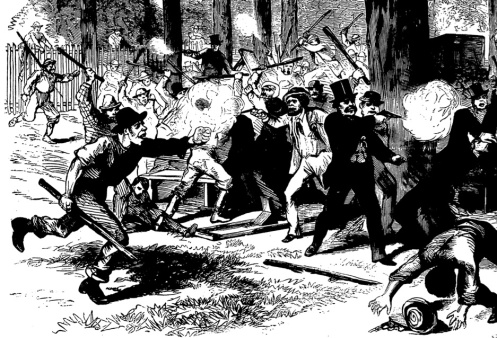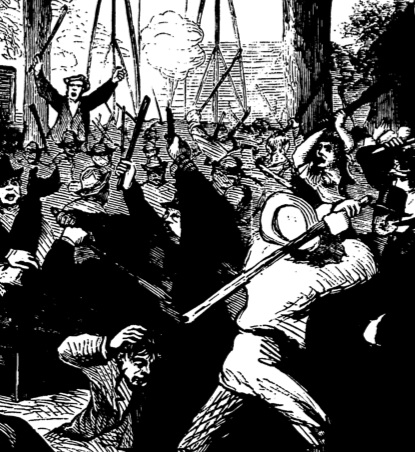Irish Stick Fighting in Old New York
“They rushed onwards, howling and screaming in a savage manner…”

Detail from Frank Leslie’s Illustrated Magazine, July 12, 1870, depicting a riot in Manhattan between Irish Catholic and Protestant Immigrants
The use of the stick, shillelagh, and cudgel in the violent “faction fights” of nineteenth century Ireland is already well-known through the works of author William Carleton (1794-1869).
Less known, however, are the historical accounts of such weapons being used in New York City among the street battles of Irish Catholic and Irish Protestant immigrants. Although such skirmishes were popularized by the film “Gangs of New York” (based on the book by Herbert Asbury), those fights were fictionalized and dramatized to a great degree. And, in actuality, Irish stick-fighting in New York City dates to nearly fifty years earlier than the events depicted in that book and film.
“Hays escaped almost certain death from a large shillelah, by a movement vulgarly called dodging…”

Detail from Frank Leslie’s Illustrated Magazine, July 12, 1870, depicting a riot in Manhattan between Irish Catholic and Protestant Immigrants
New York during the nineteenth century was a dangerous place, and as such, many citizens of both the lower and upper classes carried personal sidearms. For the lower classes, the cheapest weapon was often that which cost nothing and was immediately at hand–such as a stick, board, brickbat, club, or stone. The traditional Irish stick weapon was the shillelagh, typically made from the branch of the Irish blackthorn tree:
“The shillalah proper is about four feet long and is usually made of blackthorn, oak, ash, or hazel; and it is a great point to get it uniform in thickness and in weight throughout its entire length. It is held somewhere about eight inches or so from the centre, and my countrymen, who are always pretty active on their pins when fighting, use their left forearms to protect the left side of their heads.” – Rowland George Allanson-Winn, quoted from The Victorian Gentleman’s Self-Defense Toolkit
Just how many Irish immigrants brought their blackthorn shillelaghs with them to New York City is a matter of speculation; certainly, there are records of some having done so (particularly Irish American politicians, who would carry them as symbols of their station). During the early nineteenth century, the American press often referred to the sticks used by Irishmen in combat as shillelaghs, however, these may very well have been simple (non-blackthorn) sticks or canes that were acquired in America.

Illustration of Shillelagh technique, from Donald Walker’s “Defensive Exercises”, London: Thomas Hurst, 1840.
Although the stick was used by the Irish for the settlement of disputes and in one-on-one fights, most of the accounts reported in the local New York press describe street battles involving many participants; no doubt such sensational events were considered more newsworthy. The following, for instance, appeared in the New York American on March 31, 1825:
Several months later, on June 8, another fracas was reported in the pages of the American:
“They were actually fighting when taken, stripped to the buff…”
Ten years later, a “ferocious” riot involving Irishmen sympathetic to President Andrew Jackson was reported by the New York Commercial Advertiser, in which “a man was instantly killed by a blow from a shillelagh”:
If these newspaper reports are to be relied upon, the indication is that such pitched street battles only increased in scale. The following article, published on April 21, 1842, in the Jamestown (NY) Journal, provides an account of a battle involving a force of 300 Irish, determined to wreak vengeance for a “general attack” upon the Irish immigrant population by a gang known as the “Spartans”:
“The Irish proceeded to rally their forces, and armed with sticks of cord wood and clubs, paraded through Centre-street, about 300 strong, attacking indiscriminately and knocking down nearly everything that came in their way…”
Such riots continued through the Civil War era (when the infamous New York Draft riots exploded, involving a large number of Irish) and well into the 1870s, culminating in a massive clash of Irish Catholics and Protestants on Eighth Avenue. We’ll cover these and more in Part 2 of this article (stay tuned).

Full Image from Frank Leslie’s Illustrated Magazine, July 12, 1870. The caption reads: “New York City.—Scene of the riot at Elm Park, Eighth Avenue and Ninetieth Street, between Protestant and Catholic Irish, on Tuesday, July 12, 1870.”
In the meantime, the following song, published in the April 13, 1811, edition of the New York-based Shamrock, or, Hibernian Chronicle gives one a general idea of how the violent and romantic aura of the Irish shillelah continued to grow on American shores:








If you are interested in Irish stick-fighting and shillelaghs, please check out my books on Amazon:
Sincerely,
John
LikeLike
Hi John–I already have your book on the Shillelagh! Good stuff, thanks!
LikeLike
I’m interested in finding a school in NC for bataireacht.
LikeLike
Have you tried contacting Maxime Chouinard, or some of the people in the following group? They may be able to help: https://www.facebook.com/groups/192699714146645/
LikeLike